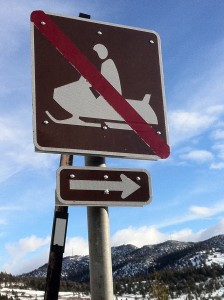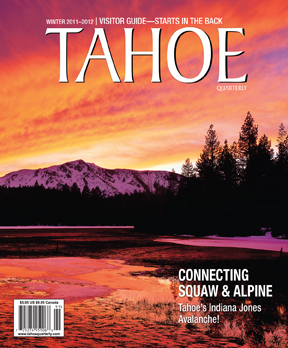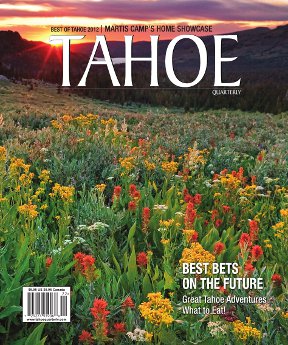War of the Roses
By defining the division between opposing sides with an actual physical or geographic border—the proverbial “line in the sand”—in the hope of promoting resolution through separation, the discourse may only become darker. Consider the symbolism of the Mason-Dixon Line or the Tug Fork of the Big Sandy River, dividing the Hatfields and McCoys during their messy 26-year-long “we-hate-your-guts” fest.
In 2002, the USDA Forest Service turned the Mt. Rose Highway into its own 38th parallel of sorts, hoping that segregation would calm the waters between the snowmobiling community and the non-motorized winter recreationalists.
What’s the matter at the Meadows?
Off Highway 431 above Incline Village, the Tahoe Meadows is a four-square-mile chunk of land, its management divided between the Carson Ranger District (CRD), which has jurisdiction over the majority of the Meadows, and the Lake Tahoe Basin Management Unit (LTBMU). The estimated 500 vehicles parked along this half-mile stretch of highway bring upwards of 1,000 people on many a winter weekend and confirms the Meadows’ status as a highly desirable, easily accessible and in-demand outdoor playground.
The non-motorized user group, which comprises back- and cross-country skiers, snowshoers and families whizzing down hills on bright plastic saucers, asserts that snowmobiles create safety issues, are unacceptably noisy and compromise their wilderness experience. Snowmobilers retort that the areas available to them are constantly shrinking with no end in sight to new restrictions. In reaction to a mounting heap of complaints, incidents and occasional nastiness, winter motorized use was restricted, almost exclusively, to the north side of Highway 431. Eight years later, has this dividing line decreased friction? Not so much.
High tension zone
Hostilities seem to be just as high as the day the first signs went up directing snowmobilers to unload only on the north side of the highway. “This is definitely a hot-button issue,” says LTBMU’s public affairs officer, Cheva Heck. “It’s one of the most heavily commented-on situations.” Genny Wilson, CRD’s district ranger, feels that the standards put on motorized use are appropriate, even though unpopular with some users.
“There are actually very few formal complaints, though we still hear plenty from both sides,” she says.
The initial move to relegate snowmobiles to a specific area was spearheaded by Snowlands Network, a nonprofit advocacy group operating in California and Nevada to promote “opportunities for quality human-powered winter recreation and protect winter wildlands.” Since the group’s founding in 1999, it has reviewed the research and conducted some studies concerning user group specifics and environmental quality in the interest of creating a safe and peaceful environment for non-motorized snow revelers. The Quiet Quadrant, the group’s current endeavor, proposes that the Forest Service completely ban snowmobile use from Brockway Summit to Spooner Summit along the northeast shore of The Lake.
Snowlands president, Gail Ferrell, maintains that the Tahoe Meadows corridor is, by far, the most popular winter use area in the Sierra. With most visitors employing human power, not a combustion engine, she says that it is too dense geographically for mixed use. “We’re not against snowmobiles,“ she says. “The question is where is it appropriate to use a snowmobile? This area is far too small for the reality of the machines’ technology—snowmobile use is not appropriate there.”
Snowlands is also proposing that all two-stroke snowmobiles be banned from the Basin entirely, just as two-stroke jet skis are banned from The Lake, because of their polluting qualities.
is More better?
Ferrell’s position that the Meadows provide too few acres to accommodate its thousands of visits is echoed by Doug Dawson, president of the Tahoe Sierra Snowmobile Club. “The area receives heavy use,“ he says. ”The OSV (oversnow vehicle) area is so small; everybody is just piled up on each other. If more area was opened up for all-around use, it would allow people to spread out.”
The LTBMU is currently working on a revised forest plan, which could impact the motorized versus non-motorized debate.
“Our revisions take into consideration comments on both sides of the issue,” says LTBMU’s Heck. “We will solicit public comment on all the different alternatives of the draft-revised plans.”
Will those plans potentially eliminate snowmobile use entirely from the Tahoe Meadows area? “Is it an appropriate activity and is it in an appropriate location? That’s the question,” says Heck, in general reference to any activities considered for Forest Service land. “It’s a small forest, and while it is open to multiple uses, we don’t have to provide every single opportunity in every location. We’re trying for some balance of opportunities forest-wide.” CRD’s Wilson is equally ambiguous in forecasting potential directions of the future management plan. “I can’t predict that. The Forest Service is a multiple-use agency and we see both uses as appropriate.”
Increasing awareness
The LTBMU is considering immediate implementation of improved signage to specify where snowmobiles are and are not permitted. Dawson feels that current signage is clear to snowmobilers but not to snowshoers and skiers, with some individuals unaware that snowmobiles are permitted on the north side of the highway.
“I’ve had skiers stand and block the trail, intentionally not moving, creating a dangerous situation for themselves and the snowmobilers trying to get around them,” says Dawson, who works at the Mt. Rose Relay Microwave Site and uses a snowcat to access the area when maintenance work is required. He believes that skiers are not educated about legitimate use of snowcats and snowmobiles for backcountry access. “Last winter when we went up to service the site, a guy flung a ski pole at us,” he adds.
We’re not alone
This conflict between the motorized community and non-motorized winter advocates is by no means a local problem. Groups on both sides have been established on the national level and conflicts can be found in every state that gets enough snow to play in. Winter Wildlands Alliance, a nonprofit advocating a quiet, safe and tranquil experience for all human-powered snow sport enthusiasts, offers links on its website to resources about enjoying quiet winter recreation. On the other side, the nonprofit Snowmobile Alliance of Western States (SAWS) provides a link on its website to a petition lobbying against the increasing geographic limitations being placed on snowmobiling.
“We have to bring a broader view to the situation because this land belongs to us all,” says Fred Wiley, president of the California Nevada Snowmobile Association. “We all have a right to use, so we need to coexist.” Wiley points out that 14 million acres, 13 percent of the state of California, is off-limits for motorized uses. Add to that, a petition signed by 90 environmental groups was just presented to the Forest Service, requesting that the exemption of snowmobiles in the 2005 Travel Management Plan be reversed, which would create further restrictions. Enough is enough, says Wiley.
Forrest McCarthy, Winter Wildlands public lands director, disagrees. “We can appreciate snowmobilers’ loss of land use but the ski community feels we’ve lost a tremendous amount of area, too,” he says. “Areas that have historically been used by backcountry skiers now see snowmobile visits because the machines have become much faster and can cover vastly more territory.” Improvements in technology and equipment, both for skiers and snowmobilers, mean more people accessing the backcountry than ever before, says McCarthy. And more access to more terrain means more contention. “Because of increasing motorized and non-motorized use, the conflict is still escalating,” he says.
Peace in our time
While the conflict remains touchy and complicated across most snow-covered states, peace was established in Idaho’s Wood River Valley and remains standing. Following years of unpleasant and hostile exchanges, the snowmobile and backcountry skiing communities were more or less forced to sit down together and work out a compromise. Feet were held to the fire by the Forest Service supervisor and a deadline was laid down with the promise that if the two enemies didn’t resolve the problem, the Forest Service was going to enact its own usage rules. Apparently, the turning point towards meaningful collaboration was a group excursion, where members tried out the other’s sport; after ten months of considerable work, specific use areas were agreed upon. Ten years later, the two user groups are still separately living happily ever after.
Why can’t we all just get along?
Is there any possibility that Tahoe Meadows will find similar peace between the warring winter factions? LTBMU’s Heck suggests that users educate other users. “It would be good if the snowmobilers reached out to the non-motorized groups and vice versa,” she says. The Tahoe Sierra Snowmobile Club is working on instituting a ridealong program where members spend a day with forestry personnel, circling the perimeter of the Mt. Rose Wilderness boundary, in the interest of better educating its membership and being involved in the management process.
“Rather than just complain, we want to be of assistance.” says Dawson. “Our club promotes snowmobiling and taking care of the environment we ride in. The non-motorized group might find that we have a lot in common.” “The motorized community is much more organized, they have a greater herd instinct,” says McCarthy. “Snowmobilers have riding clubs in all their communities. How many backcountry skier clubs have you ever heard of? But by being engaged, skiers can make a difference. Their comments do matter.”
Resolution road
One sentiment that both parties whole-heartedly agree upon is that the issue is complex. “It’s quite complicated,” says Ferrell. “Safety, natural resource preservation and noise should be considered in all land planning decisions.”
The road to resolution remains bumpy. Until peace does prevail at the Tahoe Meadows, tracks will undoubtedly cross but hopefully everyone will continue to work for the day when Highway 431 goes back to being just a highway and not a line across which to fire shots. By Vangela Wightman. TQ







